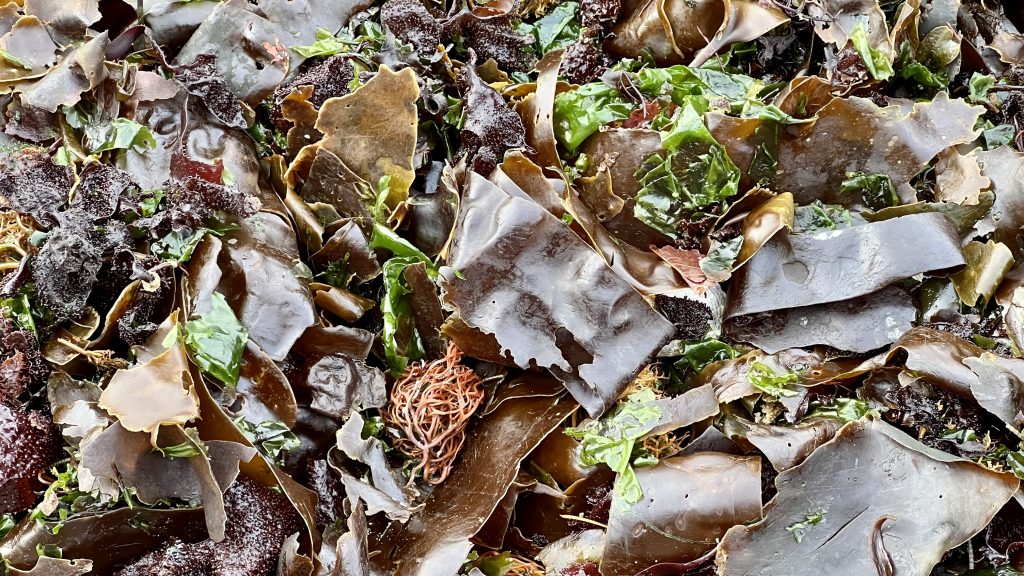December 5, 2023
Watch the video recordings of the December 2022 Seaweed Knowledge Symposium online

The seaweed of Puget Sound. Photo credit: Simone Alin
Seaweed aquaculture in Washington is a bit like the “Cheshire cat”: though there are a handful of commercial farms and restoration projects, a few pending permits, and a whole lot of enthusiasm, it’s mostly not there…yet. Whether seaweed farming will truly take off in this state, and how, is an open question. But amidst this uncertainty lies opportunity.
The foundation being laid for seaweed farming and restoration efforts today may set precedents for years to come. Given the unknowns — and the stakes — maintaining communication and collaboration among everyone involved in the burgeoning seaweed space is imperative. “We’re trying to foster a culture of cooperation and adaptive management,” said Meg Chadsey, carbon specialist at Washington Sea Grant (WSG). “We need to be able to try new things, learn from them, and be open to changing course.” Chadsey had these ideas in mind when she organized Washington’s first ever Seaweed Knowledge Symposium in December 2022 in Lacey, Washington. (Video recordings of the event are available on WSG’s YouTube channel).
The Symposium addressed four key goals: developing a deeper understanding of the local seaweed community’s interests and concerns; equipping that community to make responsible decisions around seaweed farming; understanding the gaps between the current state of knowledge and aspirations and goals for seaweed farming; and inspiring participants to work together to address information gaps and policy questions. “One of the main goals of the Symposium was to increase communication and connection within the seaweed community,” said Nicole Naar, social science and education specialist at WSG, who helped plan the event.
Speakers at the Symposium represented a broad range of expertise and experience, from the uptake of contaminants by seaweed to restoring declining wild kelp forests to the limitations of growing seaweed to sequester carbon. The perspectives of local Indigenous community members were also sought out and emphasized. Tela Troge, a member of the Shinnecock Nation in New York, offered her perspective on farming seaweed to assert tribal sovereignty, particularly as urban development and greenhouse gas emissions threaten traditional practices. “I think of ways I can protect the water so my son can engage in fishing rights for years to come,” said Troge. “My answer was seaweed farming.”
Many Indigenous people in the Pacific Northwest similarly see farming seaweed as a way to reclaim aspects of their culture. “In the past, seaweeds were always part of our everyday life,” said Loni Grinnell-Greninger (“yúčciʔə”), Tribal Council Vice Chair of the Jamestown S’Klallam Tribe. “When treaties were signed and settlers were moving in and we were removed from our land, some of our relationships with kelp and seaweed broke. So now we’re getting reacquainted.” Grinnell-Greninger and others spoke to the importance of non-tribal seaweed growers understanding this history and the position of treaty tribes in Washington as co-managers of marine resources. “I would ask any prospective seaweed farmer to acknowledge that your farm may be on ancestral territory of a Tribe,” she said. “I would ask any farmer to think about that, and to farm with good intentions. I would also encourage that farmer to think about partnering with a local Tribe.”
Helping to heal the environment is often cited as a primary motivation for aspiring seaweed farmers. Speakers at the Symposium covered the potential of growing seaweed to provide habitat to salmon and other animals, as well as absorb the excess carbon dioxide that’s causing ocean acidification. As efforts to restore wild kelp beds ramp up in Washington, there’s increasing opportunity for interplay between seaweed farming and seaweed restoration. Lee-Ann Ennis, who cultivates kelp on the Sunshine Coast in British Columbia, began farming native seaweeds to provide fish habitat, and now sees forage fish spawning on her kelp. “There is a lot of overlap between kelp farming, research and restoration,” Ennis said.
For others, seaweed farming simply represents a relatively less-impactful method of producing food. “From a planetary perspective, we’re more than 8 billion people,” said Joth Davis, a scientist and founder of Blue Dot Sea Farms. “We need to address the food supply — and that’s going to include using the ocean in ever-increasing ways.”
“Puget Sound needs a lot of help,” said Meg Chadsey, who also coordinates the Washington Seaweed Collaborative. “We can’t afford to ignore potential solutions. In the years to come, I predict we’ll be trying a lot of things we’ve never done before.”
###
Washington Sea Grant, based at the University of Washington, helps people and marine life thrive through research, technical expertise and education supporting the responsible use and conservation of coastal ecosystems. The National Sea Grant College Program is part of the National Oceanic and Atmospheric Administration, U.S. Department of Commerce.
www.wsg.uw.edu.
Join the conversation: instagram.com/waseagrant and Facebook.com/WaSeaGrant.
DEC
2023